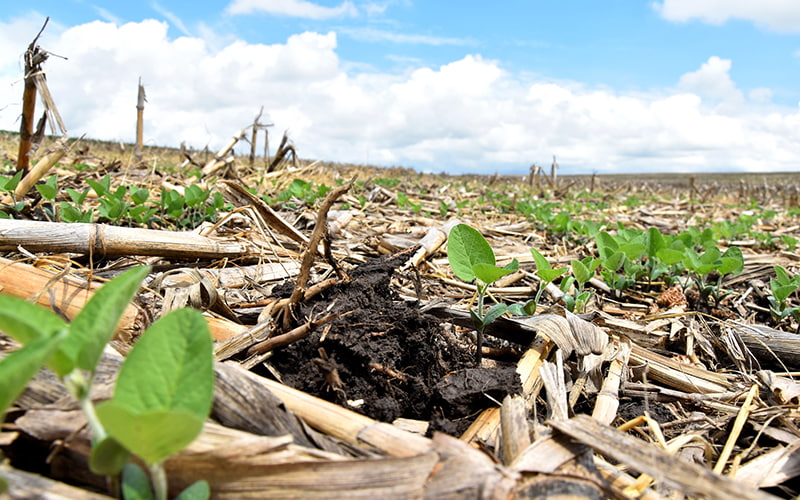How much fuel can farmers save each year by transitioning from conventional tillage to continuous no-till? According to a new report from USDA’s Conservation Effects Assessment Project (CEAP), 3.6 gallons per acre is a reasonable estimate. With current off-road diesel fuel prices*, this could translate into approximately $17 per acre saved annually.
Decrease Tillage, Improve Soil Health and Use Less Fuel
Nearly 87 percent of all cropland acres nationwide are farmed using some form of conservation tillage, where tillage is reduced for at least one crop within a given field. Continuous no-till accounts for 33 percent of this total.
Improving soil health is one known benefit of limiting disturbance. Farmers who minimize tillage across their operation may reduce soil erosion, maximize water infiltration, improve nutrient cycling, build organic matter, and strengthen resilience to disaster events or challenging growing conditions.
Based on the latest data, they may also use significantly less fuel than with conventional tillage and reduce their associated carbon dioxide emissions.

According to CEAP, farmers who implement conservation tillage practices instead of continuous conventional tillage:
- Reduce potential nationwide fuel use by 763 million gallons of diesel equivalents each year, roughly the amount of energy used by 2.8 million households.
- Reduce potential associated emissions by 8.5 million tons of carbon dioxide (CO2) equivalents each year, equivalent to removing nearly 1.7 million gasoline-powered passenger vehicles from the road.
How is this possible? Annually, farmers who practice continuous no-till use approximately 3.6 fewer gallons of fuel per acre than if they practiced continuous conventional tillage. Farmers who practice seasonal no-till – farming without tilling for at least one crop – use approximately 3 fewer gallons of fuel per acre than they would with conventional tillage year-round.
Acre by acre, fuel saved is money saved. Let’s assume an average off-road diesel fuel price of $4.75 per gallon*. By transitioning from continuous conventional tillage to continuous no-till, a farmer can save just over $17 per acre each year in fuel costs. A farmer who transitions from continuous conventional tillage to seasonal no-till can save more than $14 per acre on fuel annually. These potential savings are significantly larger than with CEAP’s first fuel savings report, primarily due to the current price of diesel fuel.
The bottom line for farmers: Reducing tillage leads to fuel savings that deliver significant financial benefits while building healthier soils for a more resilient operation.

USDA Can Help
If you’re a farmer interested in reducing tillage or pursuing other conservation efforts across your operation, USDA’s Natural Resources Conservation Service (NRCS) can help.
- This blog offers five simple tips for farmers interested in trying no-till for the first time.
- This 90-second video provides a description of no-till and associated benefits according to a Delaware farmer.
- This 23-minute video follows five South Carolina farmers seeking to quantify the benefits of conservation practices that support soil health.
- This webpage details principles to improve soil health, including reduced tillage and complimentary conservation practices such as cover crops, crop rotations, and rotational grazing.
NRCS has local USDA Service Centers in nearly every county across the United States. You may find contact information for your nearest Service Center here. NRCS staff are available to provide free, one-on-one assistance with a suite of practices to strengthen your operation, conserve natural resources, and boost your bottom line. SMART nutrient management, for example, is important to consider with no-till and may help you save money on fertilizer while improving water quality – another win-win.
Visit the new NRCS website to learn more about conservation basics, getting assistance from NRCS, programs and initiatives, and resources to inform management decisions. Visit the new CEAP webpage for additional information about USDA’s efforts to quantify the effects of conservation practices across croplands and other working lands.
*An average off-road diesel fuel price of $4.75 per gallon was calculated using data from the U.S. Energy Information Administration. Since farmers do not pay taxes for off-road diesel, the sum of federal and average total state taxes charged for diesel fuel as of July 1, 2022 - $0.5785 per gallon – was subtracted from the U.S. on-highway diesel fuel price reported on November 11, 2022 – $5.333 per gallon.
Elizabeth Creech is a Natural Resources Communication Specialist with the Natural Resources Conservation Service’s Resource Inventory and Assessment Division.


